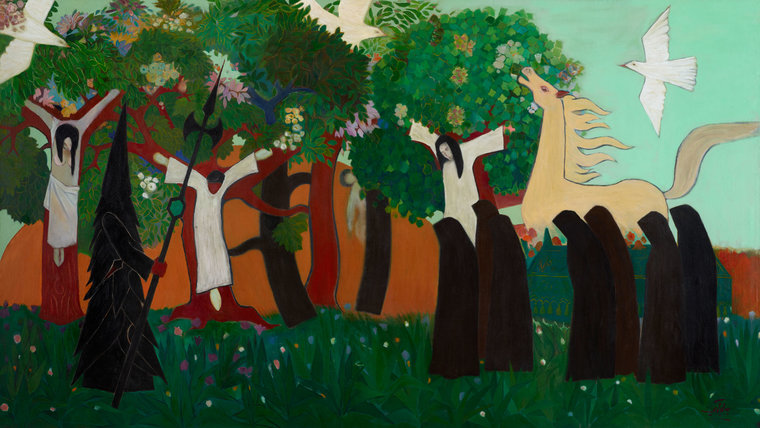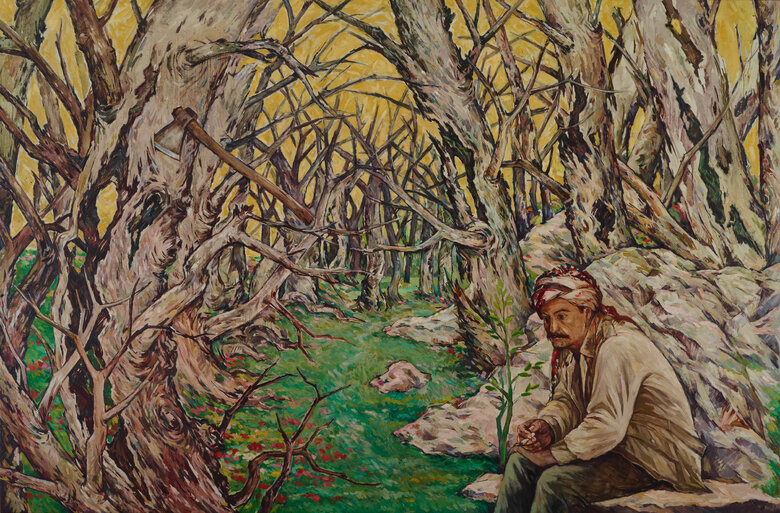Written by Carolina Sophia Pedrazzi
The Massacre of Deir Yassin, 1973, by Lebanese artist Abdel Hamid Baalbaki, is a figurative depiction of the historical April, 9, 1948 Deir Yassin massacre in Palestine. The bright veridian green, earthy burnt umber, and burnt ochre palette, along with the blooming flowers is a reflection of springtime, the season of rebirth during which the massacre took place. These colors brutally clash with the theme of the painting, and particularly with the stark image of the four figures of murdered Palestinians, one of whom is clearly a woman in a state of undress, shrouded in white and crucified upon the blossoming trees. On the left is an ominous dark figure holding a spear with a dagger at his side, embodying Death. Facing him are seven silhouetted and hooded figures who are witnessing the scene ahead. In the background, a horse is galloping while three white doves soar above. Obscured behind the hooded figures is a geometric shape of what appears to be a tomb covered in decorative tassels. The springtime colors along with the macabre scene depicted work together to exacerbate the sense of eeriness in this painting.
The massacre in Deir Yassin is a critical point in Palestinian and Arab modern history. In 1948, the Palestinian village was sacked, burnt, and raided by Zionist militias.1 The local inhabitants were forcibly expelled, and many were brutally killed, raped, tortured, and burnt alive as they tried to protect their land from invaders. Eyewitnesses describe seeing Palestinians murdered by being hung on burning trees - the same gruesome and unfathomable image that Baalbaki chose to depict in his homage to the massacre.2 Historians have described this event as the first “tile” in the domino of Palestinians’ ethnic-cleansing, which quickly led to the Nakba.3 To this day, the photographic archive of the event has not been unsealed, and the IDF has refused to share it because of the “risk in reputation” that it would entail for “Israel”.4
This painting is an outstanding example of Baalbaki’s conception of art’s essential role. Indeed, his approach to artistic production was primarily shaped by his political perspective and engagement.5 Artistic expression, for Baalbaki, comes with the political responsibility of giving paintings a purpose beyond the canvas. In terms of artistic production, Baalbaki focuses on the figurative instead of the abstract since, in his view, it allows for the political potential of the artwork to become more salient.6 As seen in other oeuvres of his, most notably The War Mural, 1977, the artist entrusts to figurative representations a political and/or social critique.7 Only 6 years prior, the Six-Day War occurred, and in the same year Baalbaki produced The Massacre of Deir Yassin, the Yom Kippur war unfolded.
The Massacre of Deir Yassin is rich in symbolism. The Palestinian victims, hung as if crucified to the trees, are the most evident example. With their white garments enhancing their virtue, the crucifixion scene conveys the message of betrayal, helplessness, and innocence that the victims endured and embodied. It is worth noting that, in addition to the crucifixion, the figure of Death and the hooded witnesses all recall European medieval visual representations. This is not the first or only case where Baalbaki uses such crusader-like tropes as a repertoire for his paintings. We can see, for instance, in The War Mural,8 a painting condemning the atrocities Lebanon suffered due to its Civil War, soldiers dressed as crusaders and a Pietà.9 The orange background is a reference to the Zionist militias setting fire to the village and the nature surrounding it. Nevertheless, the macabre, mournful painting conveys a message of hope and rebirth, symbolized through small details such as the colorful flora, and the doves, representing peace. The white horse is also a sign of strength, courage and rebirth for the Palestinian people.
Baalbaki’s poignant, tangible scene, reinforced by the strong lines and vivid colors, illustrates different aspects of his artistic production, both in his aesthetic/figurative choices and in the political direction of his oeuvre.
Edited by Boushra Batlouni
Notes
1Sana Hammoudi, “The Deir Yasin Massacre, 9 April 1948,” palquest, accessed January 23, 2024, https://www.palquest.org/en/highlight/21194/deir-yasin-massacre-9-april-1948.
2Ofer Aderet, “Testimonies from the Censored Deir Yassin Massacre: ‘They Piled Bodies and Burned Them,’” Haaretz.com, July 16, 2017, https://www.haaretz.com/israel-news/2017-07-16/ty-article-magazine/testimonies-from-the-censored-massacre-at-deir-yassin/0000017f-e364-d38f-a57f-e77689930000.
3Imeu, “IMEU Institute for Middle East Understanding,” IMEU, April 5, 2023, https://imeu.org/article/explainer-the-deir-yassin-massacre.
4 Born in Deir Yassin, 2017, Born in Deir Yassin, 2017, https://mubi.com/en/lb/films/born-in-deir-yassin.
5 Wafa Roz and Alessandra Amin, “Abdel Hamid Baalbaki - Artists,” Dalloul Art Foundation, accessed January 23, 2024, https://dafbeirut.org/en/abdel-hamid-baalbaki.
6 Jamal Joumaa, “Australian Artists of Arabic Origin Identity and Hope,” The University of Western Sydney College of Arts , 2009, https://researchdirect.westernsydney.edu.au/islandora/object/uws:7002/datastream/PDF/view, 44.
7 “Abdel-Hamid Baalbaki: The Lost-and Sometimes Found-Murals,” Saradar Collection, accessed January 23, 2024, http://www.saradarcollection.com/saradar-collection/english/programes/adel-hamid-baalbaki.
8 Ibid.
9 Ibid.
Sources
“Abdel-Hamid Baalbaki: The Lost-and Sometimes Found-Murals.” Saradar Collection. Accessed January 23, 2024. http://www.saradarcollection.com/saradar-collection/english/programes/adel-hamid-baalbaki.
Aderet, Ofer. “Testimonies from the Censored Deir Yassin Massacre: ‘They Piled Bodies and Burned Them.’” Haaretz.com, July 16, 2017. https://www.haaretz.com/israel-news/2017-07-16/ty-article-magazine/testimonies-from-the-censored-massacre-at-deir-yassin/0000017f-e364-d38f-a57f-e77689930000.
Born in Deir Yassin, 2017. Born in Deir Yassin, 2017. https://mubi.com/en/lb/films/born-in-deir-yassin.
Hammoudi, Sana. “The Deir Yasin Massacre, 9 April 1948.” palquest. Accessed January 23, 2024. https://www.palquest.org/en/highlight/21194/deir-yasin-massacre-9-april-1948.
Imeu. “IMEU Institute for Middle East Understanding.” IMEU, April 5, 2023. https://imeu.org/article/explainer-the-deir-yassin-massacre.
Joumaa, Jamal. “Australian Artists of Arabic Origin Identity and Hope.” The University of Western Sydney College of Arts , 2009. https://researchdirect.westernsydney.edu.au/islandora/object/uws:7002/datastream/PDF/view.
Roz, Wafa, and Alessandra Amin. “Abdel Hamid Baalbaki - Artists.” Dalloul Art Foundation. Accessed January 23, 2024. https://dafbeirut.org/en/abdel-hamid-baalbaki.
Signed front lower left in Arabic/ signed in Arabic on reverse
Scene from Arab Mythology






